Related Research Articles

Chakras are various focal points used in a variety of ancient meditation practices, collectively denominated as Tantra, or the esoteric or inner traditions of Hinduism and Buddhism.

In Hinduism, Kundalini is a form of divine feminine energy believed to be located at the base of the spine, in the muladhara. It is an important concept in Śhaiva Tantra, where it is believed to be a force or power associated with the divine feminine or the formless aspect of the Goddess. This energy in the body, when cultivated and awakened through tantric practice, is believed to lead to spiritual liberation. Kuṇḍalinī is associated with Parvati or Adi Parashakti, the supreme being in Shaktism; and with the goddesses Bhairavi and Kubjika. The term, along with practices associated with it, was adopted into Hatha yoga in the 9th century. It has since then been adopted into other forms of Hinduism as well as modern spirituality and New age thought.

Tantra refers to an esoteric yogic tradition that developed on the Indian subcontinent from the middle of the 1st millennium CE onwards in both Hinduism and Buddhism. The term tantra, in the Indian traditions, also means any systematic broadly applicable "text, theory, system, method, instrument, technique or practice". A key feature of these traditions is the use of mantras, and thus they are commonly referred to as Mantramārga in Hinduism or Mantrayāna and Guhyamantra in Buddhism.

Yoga is a group of physical, mental, and spiritual practices or disciplines which originated in ancient India and aim to control (yoke) and still the mind, recognizing a detached witness-consciousness untouched by the mind (Chitta) and mundane suffering (Duḥkha). There is a wide variety of schools of yoga, practices, and goals in Hinduism, Buddhism, and Jainism, and traditional and modern yoga is practiced worldwide.

A yogi is a practitioner of Yoga, including a sannyasin or practitioner of meditation in Indian religions. The feminine form, sometimes used in English, is yogini.

Kundalini yoga derives from kundalini, defined in tantra as energy that lies within the body, frequently at the navel or the base of the spine. In normative tantric systems, kundalini is considered to be dormant until it is activated and channeled upward through the central channel in a process of spiritual perfection. Other schools, such as Kashmir Shaivism, teach that there are multiple kundalini energies in different parts of the body which are active and do not require awakening. Kundalini is believed by adherents to be power associated with the divine feminine, Shakti. Kundalini yoga as a school of yoga is influenced by Shaktism and Tantra schools of Hinduism. It derives its name through a focus on awakening kundalini energy through regular practice of mantra, tantra, yantra, yoga, laya, haṭha, meditation, or even spontaneously (sahaja).
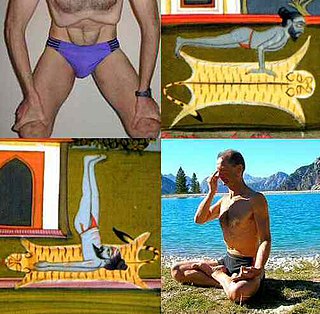
Hatha yoga is a branch of yoga that uses physical techniques to try to preserve and channel vital force or energy. The Sanskrit word हठ haṭha literally means "force", alluding to a system of physical techniques. Some hatha yoga style techniques can be traced back at least to the 1st-century CE, in texts such as the Hindu Sanskrit epics and Buddhism's Pali canon. The oldest dated text so far found to describe hatha yoga, the 11th-century Amṛtasiddhi, comes from a tantric Buddhist milieu. The oldest texts to use the terminology of hatha are also Vajrayana Buddhist. Hindu hatha yoga texts appear from the 11th century onward.
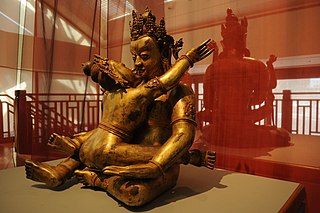
Tantric sex or sexual yoga refers to a wide range of practices carried on in Hindu and Buddhist tantra to exercise sexuality in a ritualized or yogic context.

A subtle body is a "quasi material" aspect of the human body, being neither solely physical nor solely spiritual, according to various esoteric, occult, and mystical teachings. This contrasts with the mind–body dualism that has dominated Western thought. The subtle body is important in the Taoism of China and Dharmic religions such as Hinduism, Buddhism, and Jainism, mainly in the branches which focus on tantra and yoga, where it is known as the Sūkṣma-śarīra. However, while mostly associated with Asian cultures, non-dualistic approaches to the mind and body are found in many parts of the world.
In Sanskrit texts, Rāja yoga was both the goal of yoga and a method to attain it. The term also became a modern name for the practice of yoga in the 19th-century when Swami Vivekananda gave his interpretation of the Yoga Sutras of Patanjali in his book Raja Yoga. Since then, Rāja yoga has variously been called aṣṭāṅga yoga, royal yoga, royal union, sahaja marg, and classical yoga.

Nath, also called Natha, are a Shaiva sub-tradition within Hinduism in India and Nepal. A medieval movement, it combined ideas from Buddhism, Shaivism and Yoga traditions of the Indian subcontinent. The Naths have been a confederation of devotees who consider Shiva as their first lord or guru, with varying lists of additional gurus. Of these, the 9th or 10th century Matsyendranath and the ideas and organization mainly developed by Gorakhnath are particularly important. Gorakhnath is considered the originator of the Nath Panth.
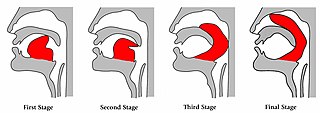
Khecarī mudrā is a hatha yoga practice carried out by curling the tip of the tongue back into the mouth until it reaches above the soft palate and into the nasal cavity. The tongue is made long enough to do this with many months of daily tongue stretching and, in some versions of the practice, by gradually severing the lingual frenulum with a sharp implement over a period of months.
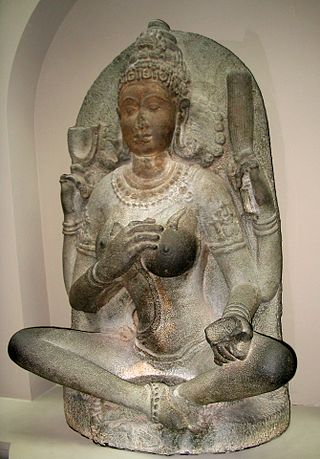
A yogini is a female master practitioner of tantra and yoga, as well as a formal term of respect for female Hindu or Buddhist spiritual teachers in Indian subcontinent, Southeast Asia and Greater Tibet. The term is the feminine Sanskrit word of the masculine yogi, while the term "yogin" IPA: [ˈjoːɡɪn] is used in neutral, masculine or feminine sense.
Neotantra, navatantra, or tantric sexuality, is a Western new religious movement partially based on Eastern spiritual traditions of Tantra. It includes both New Age and other modern Western interpretations of traditional Hindu and Buddhist tantras with an emphasis on their sexual elements. Some of its proponents refer to ancient and traditional texts and principles, and many others use tantra as a catch-all phrase for sacred sexuality, and may incorporate unorthodox practices. In addition, not all of the elements of Indian tantric practices are used in neotantra, in particular the reliance on a guru.

Gorakhnath was a Hindu yogi, saint who was the influential founder of the Nath Hindu monastic movement in India He is considered one of the two notable disciples of Matsyendranath. His followers are called yogis, Gorakhnathi, Darshani or Kanphata.
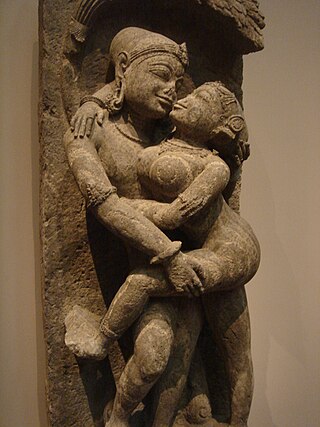
Maithuna is a Sanskrit term for sexual intercourse within Tantric sex, or alternatively for the sexual fluids generated or the couple participating in the ritual. It is the most important of the five makara and constitutes the main part of the grand ritual of Tantra variously known as Panchamakara, Panchatattva, and Tattva Chakra. Maithuna means the union of opposing forces, underlining the nonduality between human and divine, as well as worldly enjoyment (kama) and spiritual liberation (moksha).
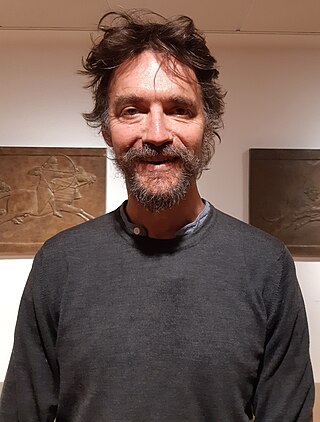
Sir James Mallinson, 5th Baronet of Walthamstow is a British Indologist, writer and translator. He is recognised as one of the world's leading experts on the history of medieval Hatha yoga.
The Amṛtasiddhi, written in a Buddhist environment in about the 11th century, is the earliest substantial text on what became haṭha yoga, though it does not mention the term. The work describes the role of bindu in the yogic body, and how to control it using the Mahamudra so as to achieve immortality (Amṛta). The implied model is that bindu is constantly lost from its store in the head, leading to death, but that it can be preserved by means of yogic practices. The text has Buddhist features, and makes use of metaphors from alchemy.

The Vivekamārtaṇḍa is an early Hatha yoga text, the first to combine tantric and ascetic yoga. Attributed to Goraknath, it was probably written in the 13th century. It emphasises mudras as the most important practice. The name means "Sun of Discernment". It teaches khecarīmudrā, mahāmudrā, viparītakaraṇī and the three bandhas. It teaches six chakras and the raising of Kundalinī by means of "fire yoga" (vahniyogena).
Shaman Hatley is a scholar of Asian religions, specializing in the goddess cults and tantric rituals of medieval India, including the yogini cults and the history of yoga.
References
- ↑ "David Gordon White: Curriculum Vitae". Academia. Retrieved 4 March 2023.
- 1 2 3 "David White". University of California, Santa Barbara. Retrieved 22 March 2019.
- 1 2 3 4 Mallinson, James (2013). "The Yogīs' Latest Trick". Journal of the Royal Asiatic Society. 24 (1): 165–180. doi: 10.1017/S1356186313000734 .
- ↑ Ramoutar, Paras (February 1994). "Criticism and Acclaim Greet Trinidad's First Woman Priest". Hinduism Today. Retrieved 20 July 2019.
- 1 2 Krishnan Ramaswamy; Antonio de Nicolas; Aditi Banerjee. "Invading the Sacred" (PDF). Rajiv Malhtora.com. pp. 73–95. Archived from the original (PDF) on 2016-06-30. Retrieved 2016-07-12.
- 1 2 3 4 Gerald James Larson (2008). "Reviewed Work: Kiss of the Yoginī: "Tantric Sex" in Its South Asian Contexts by David Gordon White". Journal of the American Oriental Society. 128 (1 (Jan. - Mar., 2008)): 154–157. JSTOR 25608318.
